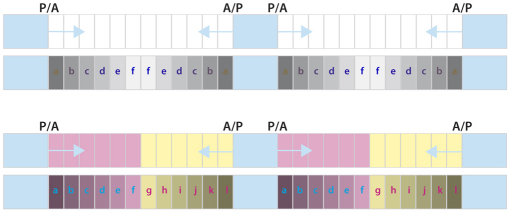Fig. 1.
Compartments and morphogens in pattern formation. The insect body plan consists of a chain of metameres divided into anterior (A) and posterior (P) compartments. Hedgehog (Hh) is produced by all the P cells and spreads forwards and backwards into the adjacent A compartments, forming concentration gradients (blue arrows) that pattern the A cells. One scenario is shown at the top: all the A cells might respond to Hh alike giving a reflexed pattern of cell types (a-f-a). However, this pattern is not observed and instead there is a single sequence of cuticle types (a-l); our explanation depends on there being two types of A cells (shown in magenta and yellow) each responding differently to Hh (Struhl et al., 1997b).

